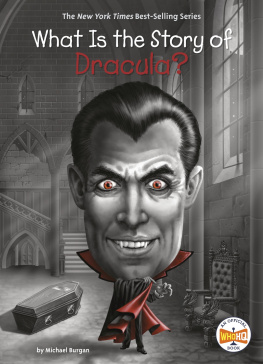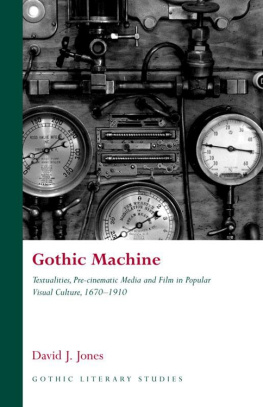Bela Lugosi and Helen Chandler in Dracula (1931) (Authors collection)
CASTLES, COBWEBS, AND CANDELABRA
In which the reader draws nearer to a modern myth,
shuddering in delicious anticipation, and discovers
the Count to be a closer relation than previously
imagined, not reflected in mirrors,
but lurking in them all the same.
THE IMAGE, OF COURSE, IS IN BLACK AND WHITE.
A womanblonde, platinum-bobbed, her face framed by a satin pillowcasesuccumbs to sleep, and more. As her eyes close, looking inward upon a dream, a mist swirls outside her open window, and within its gray depths, like an obscene, winged metronome, a huge bat hovers, eyes blazing. The cameras gazeour gazereturns to the dreaming girl, then slowly pulls back to reveal the black-cloaked figure that has replaced the flapping bat at the window. It moves forward silently, with the cold deliberation of a panther we have been here before, we know what this is the lamp at the bedside throws the features into sharp relief. The talonlike fingers make indentations on the pillow. The dark lips part, revealing a deeper darkness still, and the sleepers neck is white as radium
The scene is instantly recognizable to almost everyone in the early twenty-first century as a pivotal moment from Dracula . We may not be able to identify the exact version of the film, or even the performers involved, but the primal image of the black-caped vampire has become an indelible fixture of the modern imagination. Its recognition factor probably rivals, in its own perverse way, the familiarity of Santa Claus.
Without knowing anything of the myths origins, most of us can recite without prompting the salient characteristics of the vampirehow it sleeps by day, rising from its coffin-bed at dusk to feed on the blood of the living; its ability to take the form of a bat, a wolf, or mist; how it can be destroyed by a stake driven through its heart, and effectively repelled by garlic, wolfbane, the crucifix, or the power of the Eucharist. We have received this information by a curious cultural transfusion, not by direct experience and yet on some psychological level it must reflect some kind of universal knowledge, however veiled or obscure.
Ever adaptable, Dracula has been a literary Victorian sex nightmare, a stock figure of theatrical melodrama, a movie icon, a trademark, cuddle toy, swizzle stick, and breakfast cereal. Complex, contradictory, and confounding, Dracula tantalizingly begs the question put to the ghost in Hamlet: Be thou a spirit of health, or goblin damnd.
The appeal of Dracula is decidedly ambiguous. The emphatic white tie and black cape, so striking at first glance, rapidly yield endless shades of gray. Most monsters take and trample. Dracula alone seduces, often courting before he kills. Unlike other monsters, he is not always recognizable as such. Dracula looks too much like one of us. With patent-leather shoes and patent-leather hair, he mocks our concepts of civility and society, uses them as brazen camouflage, the better to stalk us, his readers, his film audiences, his prey.
Dracula didnt begin in Hollywood, but it traveled there with an inexorable momentum. The film medium itself had its origins in the trappings of the occult. The magic lantern salons of Paris in the late 1700s projected bat-winged demons on clouds of smoke to terrify and entertain the ancestors of the modern motion picture audience. Even today we still speak of the magic of the movies, as if, despite our sophistication about special effects, we cannot dismiss what wesee on the screen as just a set of tricks. Maxim Gorky, observing the introduction of Lumires Cinmatographe in Moscow in 1896, the year before Draculas publication, was deeply disturbed by what he beheld. To Gorky, cinema itself was a technological vampire that promised a kind of living death. Your nerves are strained, he wrote, imagination carries you to some unnaturally monotonous life, a life without color and without sound, but full of movement, the life of ghosts, or of people, damned to the damnation of eternal silence, people who have been deprived of all the colors of life.
Bram Stoker himself seems to have had certain ambitions for Dracula as a theatrical entertainment, though a successful stage adaptation would not be realized until after his death. But Dracula and vampire stories in general have found their greatest expression in the popular media, be they penny-dreadful novels, stage melodramas, or movies. Dracula has been a fixture of motion pictures since the early days of German expressionism. The character has been depicted in film more times than almost any fictional being (with the single possible exception of Sherlock Holmes) and has now so pervaded the world of communications and advertising that it is no longer necessary to read the novel or even see one of its film adaptations to be thoroughly acquainted with the Count and his exploits.
This is not the first book written on the subject of Dracula , and it will not be the last. But most treatments to date have largely ignored the fascinating history, now over a century old, of the men and women whose lives have become entangled in the myths peculiar power. Dracula has exerted an irresistible and, at times, Faustian attraction upon numerous individuals who have used the ever-expanding dream-machinery of publishing, theatre, and film to exploit the storys power and expand its influence.
Whatever else it might be, Dracula is one of the most obsessional texts of all time, a veritable black hole of the imagination. The story seems to get younger with age, drawing vitality from its longevity, and attracting an ever-widening public. Originally scorned by the critics, the book has nonetheless remained in print for more than a hundred years, and in the last decade especially has begun to attract the serious notice of academics as a significant, if problematic, Victorian text.
Since the first publication of Hollywood Gothic fourteen years ago,I have delved deeper into the Dracula myth in several other books, and I hope this revised edition reflects a widened appreciation. I am especially indebted to the proliferation of books, essays, and academic gatherings that attended the approach of the 1997 Dracula centenary and have only gained momentum since. On certain points I have altered or even reversed some of my conclusions and opinions. But as before, my approach remains eclectic and interdisciplinary; the Dracula legend rudely refuses to observe conventional parameters of discussion. Dracula lurks everywhere, and the Hollywood of Hollywood Gothic is perhaps less the geographical location than a psychic shadowland we all inhabit, that private theatre to which we return again and again to watch the midnight movies of our minds.
The changing face of Count Dracula. Clockwise from top: Cover illustration from an early twentieth-century edition of the novel (Courtesy of Ronald V. Borst / Hollywood Movie Posters); the Count, as depicted in the 1922 French edition (Authors collection); Paperback cover illustration, circa 1960 (Authors collection)












